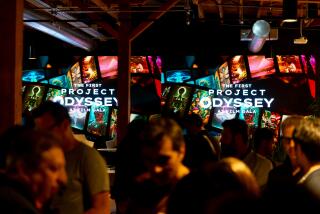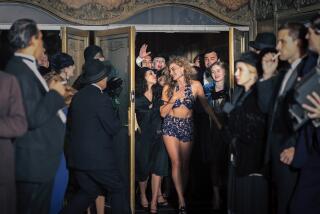Movie Frame of Mind : Kinetoscope Maker Brings Era Flickering Back to Life
- Share via
STUDIO CITY — The tiny, flickering image of a woman danced inside the 4-foot-tall wooden box, making silent armstrokes until Ray Phillips shut the film off with the tug of a lever.
“When people first saw this, they were breathless,” Phillips said, “absolutely astounded.”
Phillips, a lifelong tinkerer, snapped open the side of his handmade kinetoscope, exposing a copy of one of the world’s earliest movies, “The Serpentine Dance.”
The kinetoscope in Phillips’ workshop--basically a podium-sized peep show--contains a 40-foot loop of film and is a replica of one introduced by Thomas Edison in 1894 and abandoned soon after movie projectors hit the market a year and a half later. It was the first time the public saw a motion picture.
Phillips, 73, says he is the only person building kinetoscopes these days. In the workshop behind his Studio City home, spools and gears from the film curios are jumbled with tools and unrecognizable odds and ends.
It’s a sign of his youthful, Edisonesque nature.
“I love to get inside things and see how they work,” Phillips said. “Somehow, it keeps me sane.”
In fact, his adjacent office looks like an Edison museum, decorated with the great inventor’s writings, mementos and a blown-up picture of vintage kinetoscopes.
The retired insurance broker is something of an expert on the short-lived devices that helped introduce the world to motion pictures one person at a time. They were built, he said, solely for profit.
“People used to ask Edison why he didn’t just come out with film projectors, which he had also been working on,” said Phillips, shaking his head. “And he would tell them, ‘If I came out with 10 projectors, the whole country would have been able to watch.’ Instead he made 1,000 kinetoscopes and sold them before people ever learned about projectors.”
Phillips is painstakingly working on five replicas of the film curio--only a dozen exist today--for collectors in Spain, New York and elsewhere. Oddly enough, it’s more difficult to build them today than 100 years ago, he said, because many of the parts no longer exist and must be made by specialists.
And the founder of the Cultural Heritage Foundation of Southern California is not one to skimp on details.
“Ray’s replicas are clearly the best ever made, because he pays the most attention to the details,” said Richard Koszarski, head of collections at the American Museum of the Moving Image in New York, which bought one of Phillips’ replicas several years ago. “He knows as much as anyone in the world about them. He’s an Edison obsessive.”
Phillips plans to finish his kinetoscopes long before April 14, the 100th anniversary of the first public showing of a motion picture. Although no major celebrations are planned, many people regard the date as a contender for the start of film history.
“There’s been so much disagreement about when motion pictures actually began that we are doing a six-year celebration,” said Patrick Scott, chairman of the Motion Picture Centennial Committee. “But before April 14, 1894, we were talking about patents and experiments. This was the first public exhibition.”
The film Edison developed 100 years ago was remarkably similar to today’s--35mm with perforated edges to guide it through notched rollers. The themes were mostly repetitive and plotless, but foreshadowed modern movies.
Edison filmed Buffalo Bill shooting a rifle, a Sioux war dance, boxing matches and cockfights. “That’s right,” Phillips said. “Violence was popular then too.”
Inside his workshop, Phillips hovered over his tools, grumbling about the cabinet maker he hired to build the kinetoscope boxes.
Not that there’s a huge rush to finish.
Phillips began collecting and restoring antiques when he was 14, but was not able to savor his life’s passion full time until recent years.
“I love what I do,” he said. “I was an insurance broker for 41 years. I didn’t enjoy that at all.”
More to Read
Only good movies
Get the Indie Focus newsletter, Mark Olsen's weekly guide to the world of cinema.
You may occasionally receive promotional content from the Los Angeles Times.








